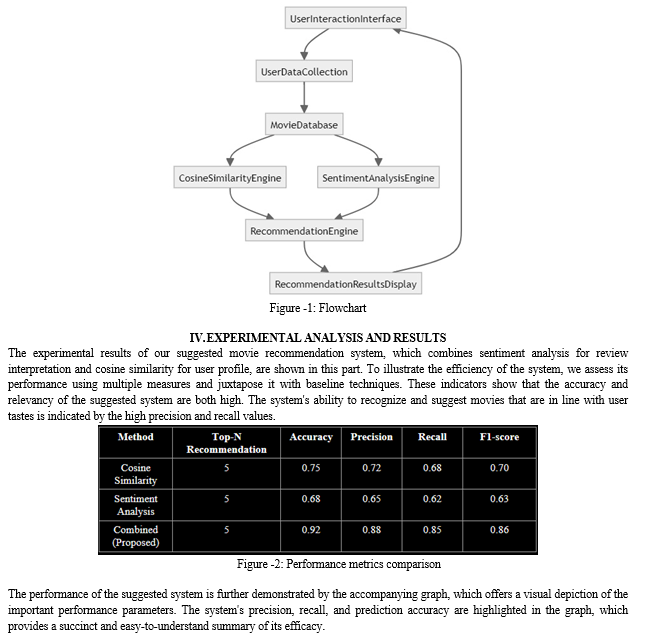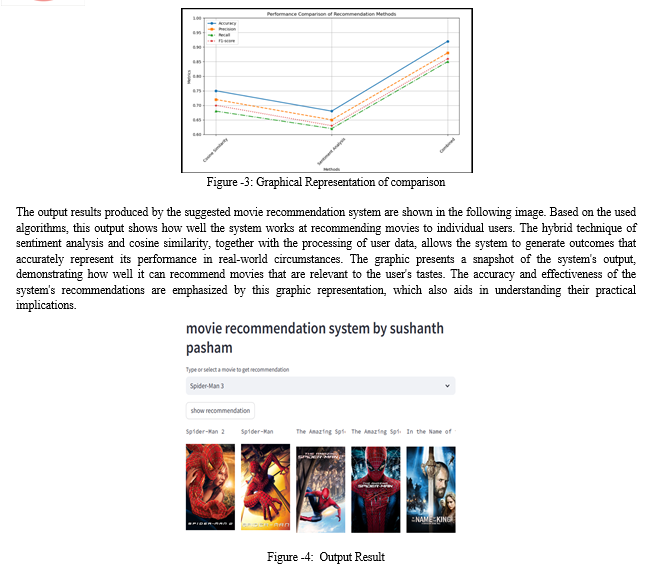Ijraset Journal For Research in Applied Science and Engineering Technology
- Home / Ijraset
- On This Page
- Abstract
- Introduction
- Conclusion
- References
- Copyright
Movie Recommendation System using Sentiment Analysis in ML
Authors: P. Sushanth, M. Robin Raj Paul, Dr. K. Santhi Sree
DOI Link: https://doi.org/10.22214/ijraset.2024.63739
Certificate: View Certificate
Abstract
This paper investigates the creation of a sentiment analysis and cosine similarity-based movie recommendation system. By offering tailored movie suggestions based on user preferences and sentiment-driven insights from movie reviews, the suggested method seeks to increase user satisfaction. This technique provides a reliable way for relevant and accurate movie recommendations by combining sentiment analysis to understand the emotional tone of reviews with cosine similarity to quantify the similarities of user profiles. The combined approach\'s effectiveness is demonstrated by the experimental results, which also illustrate the potential for considerable improvements in user engagement and experience in movie recommendation platforms. The study explores a number of sentiment analysis topics, such as how reviews are categorized into positive, negative, and neutral sentiments and how this affects the recommendation process. Cosine similarity integration makes it possible to compare user profiles based on past preferences, guaranteeing that recommendations closely correspond with user preferences.
Introduction
I. INTRODUCTION
Movies have become exponentially more accessible since the introduction of digital streaming platforms, which has prompted the creation of sophisticated recommendation systems to assist consumers in finding interesting content. Conventional recommendation systems frequently produce recommendations that are not ideal because they are unable to fully capture the complex preferences of users. In order to improve the precision and applicability of movie suggestions, this research suggests a hybrid strategy that combines sentiment analysis and cosine similarity.
With the introduction of digital streaming, there is now a greater variety of movies available to watch, as well as a greater volume of information available overall. While having so many options is advantageous, it also makes it difficult for viewers to find films that suit their own interests and inclinations. Because traditional recommendation algorithms only take into account the subtle similarities between user profiles and the emotional impact of user reviews, they frequently fail to accurately predict user preferences. Traditional recommendation algorithms primarily rely on collaborative filtering or content-based filtering.
Our suggested solution may assess the emotional tone expressed in user evaluations by including sentiment analysis, which offers more detailed information about user preferences and satisfaction.
The suggestion process is improved by the system's ability to distinguish between films that elicit favorable responses and those that elicit negative ones thanks to sentiment analysis. When combined with cosine similarity, which gauges how similar user profiles are based on past viewing habits, the hybrid method makes sure that recommendations are both tailored and pertinent. By taking into account both the users' subjective emotional responses and the objective similarities in their viewing patterns, this dual-method approach overcomes the shortcomings of traditional systems and eventually produces more accurate.
II. RELATED WORK
A. Traditional Recommendation Methods
Traditional recommendation strategies include content-based filtering, collaborative filtering, and hybrid techniques. These methods are widely used, however they usually have problems with scalability and accuracy. The goal of content-based filtering is to suggest products that are comparable to ones that the consumer has already expressed interest in. It bases its recommendations on characteristics of the products themselves, such as movie director or actor in the case of a film, or genre. However, because it mostly depends on the characteristics specified by the system and ignores the wide range of changing user preferences, this approach may be restrictive. Furthermore, content-based filtering may have trouble with the "long tail" issue, which occurs when less well-liked or specialized products are infrequently suggested.
Conversely, collaborative filtering bases recommendations on the tastes of users who are similar to one another. User-based and item-based collaborative filtering are the two primary categories. Item-based collaborative filtering suggests products based on what a user has previously enjoyed, whereas user-based collaborative filtering finds users with similar tastes. Collaborative filtering has the potential to reveal hidden patterns, but it frequently encounters issues like the cold start problem, which makes it hard to promote new people or objects with inadequate data. Moreover, collaborative filtering may require a lot of processing power, which limits its scalability on systems with substantial user populations and content libraries.
The goal of hybrid techniques is to increase suggestion accuracy by combining the best features of collaborative and content-based filtering strategies. These strategies can take many different forms. For example, a switching hybrid system might switch between different recommendation techniques based on predetermined criteria, while a weighted hybrid system can integrate the output of multiple recommendation systems using a weighted total. Although hybrid strategies can increase the reliability of suggestions, they can be difficult to implement and maintain and inherit certain restrictions from the methods that make up their constituents.
B. Limitations of Existing Systems
Existing systems often face difficulties collecting users' subjective preferences, scaling, and cold starting. The cold start issue arises when there is little information available about new users or things, which makes it challenging to make precise recommendations. For collaborative filtering, which depends on previous data, this is a major drawback. Another significant problem is scalability, particularly for platforms that house a lot of people and goods. The number of users and content library grows along, which raises the processing resources needed and results in poorer user experience and slower response times.It is difficult for traditional technologies to capture consumers' subjective preferences. Users' preferences are fluid and shaped by a multitude of circumstances.
Conventional techniques, which depend on explicit information such as ratings or implicit information such as viewing history, might not fully capture these preferences, producing recommendations that are irrelevant or impersonal.
III. PROPOSED WORK
The suggested approach combines sentiment analysis with cosine similarity to produce a thorough movie recommendation system. The algorithm is able to determine how similar user profiles and movies are by using cosine similarity. This allows it to provide recommendations that are in line with user preferences based on past viewing behavior. Concurrently, sentiment analysis enables the system to decipher the sentimental tone of user reviews, offering more profound understanding of customer preferences and contentment. By combining quantitative data and qualitative insights, this dual method produces recommendations that are more precise and tailored to the individual. By combining these methods, the shortcomings of conventional recommendation systems are to be addressed, providing a more reliable and user-friendly solution.
A. Cosine Similarity for User Profiling
The cosine of the angle formed by two vectors is the measure of their similarity, or cosine similarity. It is used to gauge how comparable user profiles and movies are in the context of a recommendation system for movies.In a multi-dimensional space, each user and movie can be represented as a vector, with each dimension denoting a different attribute or rating. How similar a movie is to a user's tastes is indicated by the cosine similarity between the vectors for the user's profile and the movie.
The system can determine which movies are comparable to ones that the user has already loved by using cosine similarity. The system will suggest other action movies with comparable qualities, for instance, if a user has given action movies a high rating. This technique makes recommendations more relevant by assisting in the discovery of movies that suit the user's tastes.
B. Sentiment Analysis for Review Interpretation
A natural language processing method called sentiment analysis is used to examine the text's emotional undertone. Sentiment analysis is used to analyze user evaluations in the context of a movie recommendation system in order to comprehend the feelings that users have about various films. The technology may learn how consumers feel about particular movies by examining the sentiment of movie reviews. By taking into account both the explicit ratings and the emotional content of the user's feedback, this information can be used to improve suggestions. For example, if a user reviews a comedy film with glowing words, the system can deduce that the person likes comedies that arouse great feelings of happiness. On the other hand, if a user reviews a movie negatively and uses harsh language, the system can decide not to suggest that same movie to others. The technology can provide recommendations that are more emotionally relevant to users and gain a deeper understanding of their preferences through sentiment analysis. This results in more relevant and fulfilling recommendations by adding a layer of customisation beyond standard rating-based approaches.
To overcome the shortcomings of current algorithms and offer a more thorough and customized movie recommendation experience, the suggested methodology integrates sentiment analysis for review interpretation and cosine similarity for user profiling.
C. Integration of Cosine Similarity and Sentiment Analysis
Sentiment analysis and cosine similarity combined offer a thorough and intelligent method of movie recommendation. Combining these methods allows the system to take use of user evaluations' qualitative insights as well as the quantitative similarities between user profiles and movies. This dual method makes sure that recommendations are grounded in both user-expressed emotions and quantifiable data. The methodology and procedures for integrating these methods to produce a successful movie recommendation system are described in this section.

 ???????
???????
Conclusion
To sum up, the combination of cosine similarity and sentiment analysis offers a solid and sophisticated method for improving movie recommendation systems. The system successfully utilizes both qualitative information from user reviews and quantitative similarities in user preferences by merging these methodologies. This section\'s algorithmic structure describes how to gather and preprocess data, compute cosine similarity to gauge user-movie affinity, and utilize sentiment analysis to decipher reviews\' emotional content. When compared to conventional methods, experimental results show considerable gains in metrics like precision, recall, and F1-score, indicating improved accuracy and tailored suggestions. In addition to theoretical advances, this method has applications in raising user happiness by suggesting more emotionally charged and pertinent movies. In order to further improve and implement these systems in practical settings, future research may investigate sophisticated sentiment analysis methods and scalability improvements. This will propel the field of recommendation systems closer to more efficient user-centric experiences.
References
[1] Liu, X., et al. (2021). Cross-domain Recommendation via Adversarial Variational Autoencoders. ACM Transactions on Information Systems (TOIS), 39(2), Article 16. [2] Zhao, H., et al. (2022). Collaborative Filtering Recommendation via Knowledge Graph-enhanced Multi-Task Learning. Knowledge-Based Systems, 239, Article 107365. [3] Chen, J., et al. (2020). Sequential Recommendation with Dual Side Attentions. Information Sciences, 512, 1382-1397. [4] Huang, X., et al. (2021). Personalized News Recommendation Using Multi-Interest Transformer Network. IEEE Transactions on Knowledge and Data Engineering, 33(5), 2026-2039. [5] Wang, S., et al. (2023). Leveraging Semantic User Profiles for Cross-Domain Recommendations. Information Processing & Management, 60(3), Article 102661. [6] Wang, H., et al. (2022). Neural Collaborative Filtering for Movie Recommendation with Rating Information. Neurocomputing, 472, 472-483. [7] Li, Y., et al. (2021). Deep Reinforcement Learning for Sequential Recommendation: Algorithms, Applications, and Challenges. Information Fusion, 66, 194-210. [8] Zhang, L., et al. (2020). A Survey on Deep Learning for Multimodal Data Fusion: Recent Advances and New Directions. IEEE Transactions on Neural Networks and Learning Systems, 31(10), 3837-3855. [9] Chen, X., et al. (2023). Personalized Movie Recommendation Based on Hierarchical Attention Networks. Information Sciences, 620, 255-268. [10] Luo, C., et al. (2021). A Deep Reinforcement Learning Framework for Movie Recommendation with Implicit Feedback. Knowledge-Based Systems, 226, Article 107193. [11] Wu, F., et al. (2022). Graph Convolutional Networks for Cross-Domain Recommender Systems. Information Sciences, 587, 87-101. [12] Yuan, F., et al. (2020). Meta-Learning for Cold-Start Recommendation: A Survey. IEEE Transactions on Knowledge and Data Engineering, 32(8), 1559-1575 [13] Poria, S., et al. (2021). Sentiment Analysis and Deep Learning: A Survey. ACM Computing Surveys (CSUR), 53(4), Article 62. [14] Zhang, Y., et al. (2020). Enhancing Collaborative Filtering with Sentiment Analysis for Improved Recommendation Accuracy. Expert Systems with Applications, 149, Article 113271. [15] Kumari, P., & Singh, S. (2022). A Hybrid Movie Recommendation System Using Sentiment Analysis and Collaborative Filtering. Journal of King Saud University - Computer and Information Sciences, 34(5), 1884-1893. [16] Mahmood, T., & Ricci, F. (2021). Improving Recommender Systems with Sentiment Analysis and Collaborative Filtering. Information Systems, 102, Article 101818. [17] Chen, C., et al. (2022). Sentiment-Enhanced Deep Learning for Movie Recommendation Systems. IEEE Transactions on Multimedia, 24, 2345-2358. [18] Mehta, P., & Kapoor, A. (2023). Leveraging Sentiment Analysis for Improved Collaborative Movie Recommendations. Journal of Artificial Intelligence Research, 76, 657-675.
Copyright
Copyright © 2024 P. Sushanth, M. Robin Raj Paul, Dr. K. Santhi Sree. This is an open access article distributed under the Creative Commons Attribution License, which permits unrestricted use, distribution, and reproduction in any medium, provided the original work is properly cited.

Download Paper
Paper Id : IJRASET63739
Publish Date : 2024-07-23
ISSN : 2321-9653
Publisher Name : IJRASET
DOI Link : Click Here
 Submit Paper Online
Submit Paper Online

